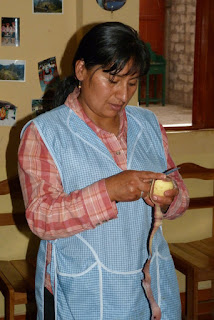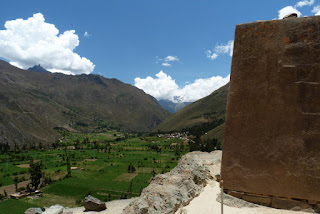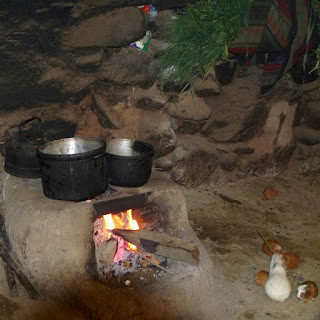The Sacred Valley of the Urabamba River (elevation ~ 9000 feet) was a key area of settlement for the Incas. Its agreeable climate and fertile plains make a rare and fruitful combination for the high Andes. It was the route to the jungle and thus an access to the fruits and plants of the tropical lowlands, as well as a buffer zone, protecting Cusco from incursions of jungle tribes who from time to time raided the highlands. Today the Sacred Valley remains a lush agricultural region.
**************
The sketch map below shows the relative location of the places we visited in the Sacred Valley.
********************************************************
********************************************************
As we entered the southern part of the valley, we headed up to Pisac – at 11,000 feet, the first serious test for the lungs. Perched high on a cliff near the village of Pisac is the largest fortress complex built by the Incas. From the top of the mountain, it commands distant views over a beautiful green valley and terraces all over every hillside.
In the upper sector of the ruins, there is a Sun Temple, with water ducts, rooms with niches and spaces for guinea pigs under the bed. Above the temple are still more ruins, mostly unexcavated.
From the temple we could see crevices and rocky overhangs where ancient burial sites were hidden. Unfortunately, looters opened most of the graves in search of gold - all that's visible today are the holes where mummies once rested.
On the steep hillsides around the temple, the Inca constructed agricultural terraces, which are still in use today. The terraces were created by hauling richer topsoil by hand from the lower lands. This enabled the production of more food than would normally be possible at high altitudes. The narrow rows of terraces beneath the citadel are thought to represent the wing of a partridge (pisaca), from which the village and ruins get their name. With military, religious, and agricultural structures, the site served at least a triple purpose. Researchers believe that Písac defended the southern entrance to the Sacred Valley, controlling the route which connected the Inca Empire with the border of the rain forest.
***************************************************************
For a different perspective on the Sacred Valley, we embarked on a rafting trip down the Urubamba River. We had to work a little, but this was a most enjoyable way to experience the enchanting Andean landscape.
Here the Inca culture was born, and here the Incas found that the area's mild climate and fertile soil yielded an abundance of fruits and vegetables. As we floated along the river, we saw Inca ruins as well as the networks of terraces on either side, constructed entirely by hand, which transformed steep mountainsides into acres of arable land that helped feed a civilization. The terraces remain in use today, centuries after their construction.
We spotted several birds along the river: speckled duck, tiger heron, black ibis, Andean gull, blue flycatcher, and … the incredible Andean condor.
We also got a look at the train to Machu Picchu – running right alongside the river, its tracks rest on stone foundations built in the 1500’s by the Incas.
And - best of all, nobody fell in ...
*********************************************************
Our lodging for our stay in the valley was a charming little retreat near the town of Urabamba – located near the center of the Sacred Valley - and our favorite lodging for the trip.
Also located in Urabamba is Pablo Seminario’s Pottery Workshop. Pablo and his wife Marilu have dedicated their lives to preserving the traditions of pre-Columbian pottery and to sculpting the red clay found in the Sacred Valley.
Their home/workshop is more than just a pottery factory; it is also a carpentry and jeweler’s workshop, and a place for research and creativity.

Using techniques and designs from ancient Peruvian cultures, the workshop, gallery and shop are filled with new expressions of an ancient art.
The courtyard was filled with lots of interesting plants. This one looked like some type of night-blooming cereus, but it was in full flower in broad daylight.
*******************************************************
While in the Urabamba area, we enjoyed a home-hosted meal at the home of Senora Emma Llano, her mother, her three daughters, and a new puppy.
For three of us with birthdays during the trip, this was no simple meal. Dennis, Cindy and Fran were decked out in ribbons and silly hats in honor of the occasion.
Fran and Cindy were recruited to help with the cooking lesson - with careful supervision from Ms. Emma, we mixed up a big batch of Peruvian tamales. Grandma was in charge of frying the tamales in the wood-burning fireplace.
Lunch was a parade of local foods, including the Andean delicacy of roasted cuy (aka guinea pig). Besides the tamales that we helped make, there were sweet potatoes, rice, lupine beans, and chica morado (purple corn juice).
After lunch, it was time for birthday cake - served in the 'traditional' manner. That means that the candles were lit, we all gathered round to blow them out, and then our lovely hostess smashed our faces into the cake. Needless to say, that was quite a surprise - and cause for much laughter from the kids and our former friends/travelling companions.
With the big meal behind us, it was time to help Ms. Emma with preparations for tomorrow's meal. She showed us how to peel potatoes and how to shell fava beans. In the Peruvian highlands, girls must learn to peel potatoes with the peeling hanging in one thin piece. When she first meets her future inlaws, she must demonstrate her skill – knowing that they’ll likely give her a rough potato and a bad knife.
With the kitchen cleaned up and food ready to cook, she gave us a tour of her home - a two-storey house with three bedrooms upstairs, kitchen/living area downstairs, and bathroom outside. It was enclosed in a high wall with broken glass on top to discourage unwanted visitors.
*****************
Down the road from Ms. Emma's is Mama Lucia's Chicharia. We had heard about these places before - a red plastic bag/flag is hung outside an establishment which makes and sells chicha, a type of beer made from fermented maize.
Of course, this was a learning and discovery opportunity as Raul introduced us to Mama Lucia, showed us the various ingredients in this mixture, and then poured us a taste. We actually tasted two varieties of this stuff – chicha, the traditional maize brew, and fruitillada, a strawberry-flavored beer.

Our "education" was a source of some amusement to the regular customers, especially the fellow in the blue sweater. He offered lots of advice about what to drink and how to drink it - too bad he only spoke Spanish and we missed most of his humor.
Drinking done, we headed out back into a courtyard area for a game of "sapo" (the Spanish word for frog or toad). This game dates back to Inca times, when it was believed that one would have good luck tossing a gold piece into the mouth of a frog. Today's game features a shiny brass frog, as well as other pocket and spinners - into which we tried to toss brass medallions.

Raul divided us into two teams, the Condors and the Pumas. In spite of our best efforts, our team lost out on the bottle of wine that Raul put up as the prize. We still had fun - and it's always a bonus to entertain the local folks.
**************************************************************
Ollantaytambo is an attractive little town located at the western end of the Sacred Valley. The town is located at the foot of some spectacular Inca ruins which protected a strategic entrance to the lower Urubamba Valley.
The temple area is at the top of steep terracing which helped provide excellent defenses. The complex was still under construction at the time of the Spanish conquest and was never completed. Even so, the ruins are said to represent one of the Inca Empire's most formidable feats of architecture.
One of us hadn't gone halfway up the hill before it was time for a break - it promised to be a formidable task just to climb this hill.
The upper section of the ruins -- reached after we climbed 200+ steps -- contains masterful masonry that adorns Inca temples. A massive doorjamb indicates the principal entry to the temple; next to it is the Temple of Ten Niches.
On the next level are six huge pink granite blocks, amazingly cut, polished, and fitted together; they appear to be part of rooms never completed.
This Temple of the Sun is one of the great stonemasonry achievements of the Incas. Across the valley is the quarry that provided the stones for the structure; a great ramp descending from the hilltop ruins was the means by which the Incas transported the massive stones -- thousands of workers essentially dragged them around the river -- from several kilometers away.
From the top, the views south over the Urubamba Valley and of the snowcapped peaks of the Andes are outstanding.

At the bottom of the terraces, next to the Patacancha River, is a place of ceremonial bathing - the Baños de la Ñusta (Princess Baths).
Wedged into the mountains facing the baths are granaries built by the Incas.
Below the ruins, the town of Ollantaytambo is said to be the finest remaining example of the Incas' masterful urban planning. Many original residential canchas, or blocks, each inhabited by several families during the 15th century, are still present; each cancha had a single trapezoidal entrance opening onto a main courtyard.

The town is a splendid grid of streets dating to Inca times and lined with adobe brick walls, blooming bougainvillea, and canals still carrying rushing water down from the mountains.
We got a little glimpse of life within a cancha by stopping in at Calle del Medio, where a couple of neighboring houses have a small shop in the courtyard. Our guide got us invited into one of the homes, where we fed green stuff to the family's guinea pigs. The guinea pigs roam free in the one-room house - they were loose in the kitchen area when we came in - they usually sleep under the owner's bed.
The entire village retains a solid Amerindian air to it, unperturbed by the crowds of gringos who wander through it, snapping photos of women and children. It's a simple, traditional place, largely populated by locals in colorful native dress and women who pace up and down the streets absent-mindedly spinning the ancient spools used in making hand-woven textiles.
We weren't the only visitors in town today - over at the soccer field, there was a women's soccer tournament featuring teams from other parts of the country. We enjoyed seeing their colorful dress (and beautiful children), but we really wished we could stay to watch them play!




















































No comments:
Post a Comment